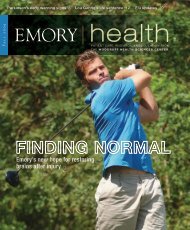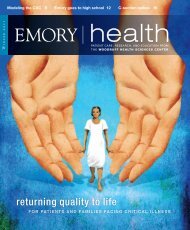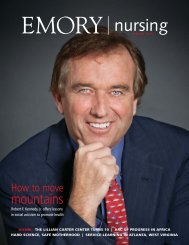Living - Woodruff Health Sciences Center - Emory University
Living - Woodruff Health Sciences Center - Emory University
Living - Woodruff Health Sciences Center - Emory University
Create successful ePaper yourself
Turn your PDF publications into a flip-book with our unique Google optimized e-Paper software.
MoVInG ForWArD MORE nEWS<br />
The epilepsy monitoring unit at <strong>Emory</strong> Hospital relies on a little help from man’s<br />
best friend. Trained assistance dogs visit regularly with patients, making a stay in the<br />
unit reminiscent of home. “Some of the animals are bred as seizure response dogs,<br />
which can be trained to remain next to a person during the course of a seizure,<br />
locate help if others are nearby, or even retrieve a phone if a patient is in the process<br />
of experiencing a seizure,” says George Fraser, the unit director. “Having these visits<br />
truly helps us brighten a patient’s stay.”<br />
When seizures are desired<br />
brenda free has suffered from epilepsy for more than<br />
25 years, since the birth of her first child. Her condition has<br />
caused lapses of memory and a repeatedly dislocated shoulder from<br />
seizures. She even lost her job as a materials planner when she was<br />
unable to manage the disease.<br />
“For years, I took medication, which helped some,” says Free.<br />
“But I never really wanted to believe or face the reality that the seizures<br />
I was experiencing were really epilepsy. I did my best to ignore<br />
and hide it.”<br />
But on a summer night in 2007, Free got a wake-up call she<br />
couldn’t ignore. When she started to seize, a friend called 9-1-1.<br />
The first responder on the scene was a police officer who arrived in<br />
advance of the ambulance. The officer, unaware Free’s violent convulsions<br />
were due to epilepsy, used a taser gun to subdue her.<br />
“After that, I just knew it was time to take control of my condition<br />
and not ignore it or sleep it away,” Free says. “I’m thankful for<br />
that night because it was a turning point.”<br />
After Free consulted with her physician in Savannah and did<br />
20<br />
eMory heAlth<br />
extensive research about epilepsy on the web, she<br />
wound up at <strong>Emory</strong>. Recently admitted to an epilepsy<br />
monitoring unit in <strong>Emory</strong> <strong>University</strong> Hospital,<br />
she hopes to pinpoint the cause of her seizures.<br />
The unit, which opened in April, helps physicians<br />
better identify the source of epileptic seizures.<br />
That, in turn, can lead to more effective<br />
outcomes and treatments.<br />
More than 40 million people currently suffer<br />
from epilepsy, a neurologic disorder that causes<br />
abnormal electrical activity in the brain resulting in<br />
recurrent seizures. The condition affects children,<br />
adults, and seniors, and it can be present at birth<br />
or brought on later by a head injury, brain tumor,<br />
or stroke. In many cases, the cause cannot be discovered.<br />
The epilepsy monitoring unit at <strong>Emory</strong> allows<br />
for continuous video and EEG monitoring of electrical<br />
activity in the brain. While a standard EEG<br />
test typically lasts 30 minutes and offers only a<br />
brief snapshot of a brain’s activity within a limited<br />
time frame, continuous monitoring can improve<br />
diagnostic accuracy. Continuous monitoring is<br />
particularly helpful when routine EEG recordings fail to indicate a<br />
diagnosis, particular seizure type, or location of onset.<br />
According to <strong>Emory</strong> neurophysiologist Suzette LaRoche, a<br />
patient with epilepsy may experience many different types of seizures.<br />
The ability to accurately diagnose those types aids in selecting<br />
effective treatment options including medication and surgery.<br />
“For many epilepsy patients, the only way to offer better treatment<br />
is to monitor them and study what occurs during an actual<br />
seizure,” LaRoche says. “The more we can learn about an individual<br />
patient’s seizures, the better our chances of being able to offer better<br />
seizure control and maybe even reduce or eliminate certain medications<br />
that cause severe drowsiness, impaired thinking, or other<br />
adverse physical effects. This is probably the only place that patients<br />
actually hope for and want to have a seizure.”<br />
That’s true for Brenda Free. “Now I am like many other epilepsy<br />
patients who come to <strong>Emory</strong> just hoping to have a seizure,” Free<br />
says, “because that is the only way to unlock what has to this day<br />
been a mystery.” —By Lance Skelly<br />
Growing up and older with cystic fibrosis<br />
When Michael Schechter was a resident in training in<br />
the 1970s, he had only one cystic fibrosis patient who<br />
made it to 20. “At the time, that was considered remarkable,” says<br />
Schechter, who today directs <strong>Emory</strong>’s Cystic Fibrosis <strong>Center</strong>.<br />
now the average life span of people with cystic fibrosis (CF) is<br />
edging toward 40. <strong>Emory</strong>’s center, for example, is treating patients<br />
like David Adkins, 53, who started jogging as a form of respiratory<br />
therapy and eventually completed four marathons.<br />
“Eventually children have to take<br />
responsibility for their own schedules<br />
and their own medications,” says<br />
Lindy Wolfenden, director of the<br />
Adult CF program. “this sometimes<br />
is an adjustment for both parents and<br />
children. It’s not that long ago that<br />
parents were told not to expect their<br />
child to live past the age of 18.”<br />
Gradual advances in patient<br />
care have transformed CF from a<br />
condition that cut short the lives of<br />
children to one in which adults are<br />
planning for their futures. Recently<br />
<strong>Emory</strong>’s adult program has expanded<br />
so dramatically that it has moved to a<br />
new location in the <strong>Emory</strong> Clinic.<br />
Because of mutations in a gene<br />
that disable the cells’ ability to transport<br />
salt, people with CF produce<br />
unusually thick, sticky mucus. the<br />
mucus clogs their airways and often<br />
leads to life-threatening lung infections.<br />
It also obstructs the pancreas, preventing digestive enzymes<br />
from breaking down and absorbing food.<br />
CF causes a gradual loss of lung function, exacerbated by infections<br />
and bronchial obstruction, says Wolfenden. Advances in<br />
treatment over the past few decades include refinements in airway<br />
clearance techniques and infection control as well as improved<br />
inhalable antibiotics and medications that thin mucus.<br />
the <strong>Emory</strong> CF center also is bolstering research to support<br />
clinical care in areas such as CF-related diabetes and vitamin D<br />
deficiency. Pulmonologist Arlene Stecenko is looking at how diabetes<br />
develops in CF patients and the mechanism by which diabetes<br />
aggravates lung disease. In another area, membrane physiologist<br />
nael McCarty is bolstering basic research on proteins that mutate<br />
in CF. Schechter is looking at the impact of patient and parental<br />
anxiety and depression on the course of disease. And the center’s<br />
clinical researchers are gearing up to participate in large-scale, mul-<br />
ticenter studies of medications that may enhance the functioning of<br />
mutant proteins.<br />
At <strong>Emory</strong>, CF patients typically visit their doctors at least<br />
every three months for a checkup and test of lung function. they<br />
use a variety of methods to clear mucus from their lungs, such as<br />
vibrating vests, inhalation of several nebulized medications, and<br />
regimens of breathing exercises and coughing. they often have<br />
diets whose caloric intake rivals that of Olympic swimmer Michael<br />
PATIENT CARE AdvANCES HAvE AllOWEd CySTIC fIbROSIS PATIENTS TO GROW PAST CHIldHOOd, SAyS<br />
lINdy WOlfENdEN, CENTER, dIRECTOR Of EMORy’S AdulT Cf PROGRAM, WHICH RECENTly ExPANdEd.<br />
Phelps, and they take enzyme supplements with each meal to aid<br />
digestion.<br />
Adults with CF have concerns ranging from having families to<br />
managing CF-related diabetes, which becomes more common as<br />
patients age. One-third of adults with CF between 20 and 29 and<br />
close to half of those over 30 develop diabetes.<br />
<strong>Emory</strong>’s CF center is one of the five largest in the country and<br />
cares for approximately 600 people through its adult program and<br />
an affiliated program at Children’s <strong>Health</strong>care of Atlanta, Schechter<br />
says. to tailor care to the growing adult population of close to 200,<br />
<strong>Emory</strong> has brought in several specialists, including an endocrinologist,<br />
a social worker, a dietician, nurses, and nurse practitioners.<br />
One of the adult patients, Craig Pubanz, 35, is happy to share<br />
advice with young people with CF: “If you take care of yourself, you<br />
can go to college, have a family, and live life to its fullest.” —Quinn<br />
Eastman<br />
Winter 2008-2009<br />
21
















